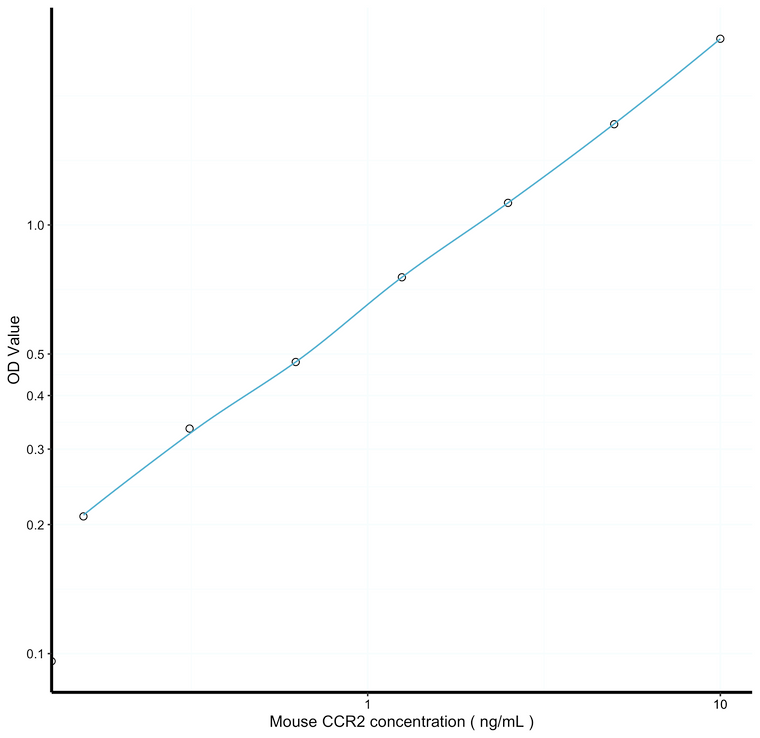| Applications: |
ELISA |
| Reactivity: |
Mouse |
| Note: |
STRICTLY FOR FURTHER SCIENTIFIC RESEARCH USE ONLY (RUO). MUST NOT TO BE USED IN DIAGNOSTIC OR THERAPEUTIC APPLICATIONS. |
| Sensitivity: |
0.061ng/mL |
| Detection Limit: |
0.156-10ng/mL |
| Short Description: |
This CCR2 Sandwich ELISA Kit, Ready-To-Use is an in-vitro enzyme-linked immunosorbent assay for the measurement of samples in mouse cell culture supernatant, serum and plasma (EDTA, citrate, heparin). |
| Storage Instruction: |
The whole kit may be stored at-20°C for up to 12 months from receipt. An unopened kit may be stored in the fridge at 2-8°C for up to 6 months. Once opened store individual kit contents according to components table provided with the kit. |
| Assay Time: |
3 hrs |
| Gene Symbol: |
Ccr2 |
| Gene ID: |
12772 |
| Uniprot ID: |
CCR2_MOUSE |
| Immunogen Region: |
Ready-To-Use |
| Sample Type: |
serum, plasma, tissue homogenates, cell lysates or other biological fluids. |
| Tissue Specificity | Epressed in mature thymocytes. Detected in monocyte/macrophage cell lines, but not in nonhematopoietic cell lines. |
| Post Translational Modifications | N-glycosylated. Sulfation increases the affinity for both monomeric and dimeric CCL2 with stronger binding to the monomeric form. Binding of sulfated CCR2 to CCL2 promotes conversion of CCL2 from dimer to monomer. |
| Function | Key functional receptor for CCL2 but can also bind CCL7 and CCL12 chemokines. Its binding with CCL2 on monocytes and macrophages mediates chemotaxis and migration induction through the activation of the PI3K cascade, the small G protein Rac and lamellipodium protrusion. Also acts as a receptor for the beta-defensin DEFB106A/DEFB106B. Regulates the expression of T-cell inflammatory cytokines and T-cell differentiation, promoting the differentiation of T-cells into T-helper 17 cells (Th17) during inflammation. Facilitates the export of mature thymocytes by enhancing directional movement of thymocytes to sphingosine-1-phosphate stimulation and up-regulation of S1P1R expression.signals through the JAK-STAT pathway to regulate FOXO1 activity leading to an increased expression of S1P1R. Plays an important role in mediating peripheral nerve injury-induced neuropathic pain. Increases NMDA-mediated synaptic transmission in both dopamine D1 and D2 receptor-containing neurons, which may be caused by MAPK/ERK-dependent phosphorylation of GRIN2B/NMDAR2B. Mediates the recruitment of macrophages and monocytes to the injury site following brain injury. |
| Protein Name | C-C Chemokine Receptor Type 2C-C Ckr-2Cc-Ckr-2Ccr-2Ccr2Je/Fic ReceptorMcp-1 ReceptorCd Antigen Cd192 |
| Database Links | |
| Cellular Localisation | Cell MembraneMulti-Pass Membrane ProteinThe Chemoattractant Receptors Are Reportedly Distributed Throughout The Cell SurfaceAfter Stimulation With A LigandSuch As Ccl2They Are Rapidly Recruited Into Microdomain Clusters At The Cell Membrane |
| Alternative ELISA Names | C-C Chemokine Receptor Type 2 ELISA kitC-C Ckr-2 ELISA kitCc-Ckr-2 ELISA kitCcr-2 ELISA kitCcr2 ELISA kitJe/Fic Receptor ELISA kitMcp-1 Receptor ELISA kitCd Antigen Cd192 ELISA kitCcr2 ELISA kitCmkbr2 ELISA kit |
| output | |
Information sourced from Uniprot.org
12 months for antibodies. 6 months for ELISA Kits. Please see website T&Cs for further guidance







